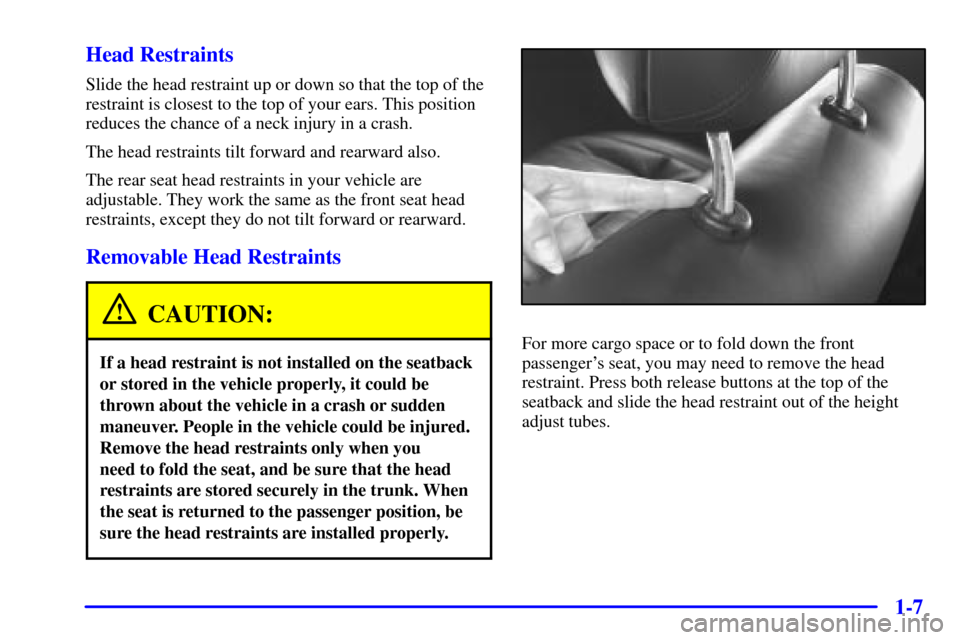Page 4 of 321
ii
Table of Contents
Keys and Door Locks
Remote Keyless Entry (RKE) System
Trunk Release
Automatic Transmission
Windows
Tilt Wheel
Turn Signal/Multifunction Lever
Windshield Wipers
Cruise ControlInterior and Exterior Lamps
Mirrors
Storage Compartments
Convenience Net
Accessory Power Outlet
OnStar® System (If Equipped)
Sunroof (Option)
HomeLink® Transmitter (Option)
Instrument Panel, Warning Lights and Gages Seats and Seat Controls
Safety BeltsAir Bag Systems
Child Restraints
Section
1
Section
2
Seats and Restraint Systems
Features and Controls
Page 15 of 321

1-3
�To adjust the seat height, lift up or push down on the
center of the control.
�To move the seat forward or rearward, slide the
control in the desired direction.
If a failure in the power supply system occurs, the
power seats can be manually adjusted by inserting the
crank handle into the slot located below the seat cushion
(as shown in the above illustration).The crank handle is provided in the tool kit located in
the trunk (with the jack).
Turn the crank handle clockwise until you've reached
your desired seating position (note that manually
moving the seat requires turning the crank handle
many times).
Sport Seats (If Equipped)
If your vehicle has this feature, the bottom of the
seat cushion extends outward to provide additional
leg support.
To extend the bottom of the seat cushion, grasp the
front portion of the cushion and pull it towards the
front of the vehicle.
When additional support is no longer needed, return
the cushion to its original position by pushing it towards
the rear of the vehicle.
Page 19 of 321

1-7 Head Restraints
Slide the head restraint up or down so that the top of the
restraint is closest to the top of your ears. This position
reduces the chance of a neck injury in a crash.
The head restraints tilt forward and rearward also.
The rear seat head restraints in your vehicle are
adjustable. They work the same as the front seat head
restraints, except they do not tilt forward or rearward.
Removable Head Restraints
CAUTION:
If a head restraint is not installed on the seatback
or stored in the vehicle properly, it could be
thrown about the vehicle in a crash or sudden
maneuver. People in the vehicle could be injured.
Remove the head restraints only when you
need to fold the seat, and be sure that the head
restraints are stored securely in the trunk. When
the seat is returned to the passenger position, be
sure the head restraints are installed properly.
For more cargo space or to fold down the front
passenger's seat, you may need to remove the head
restraint. Press both release buttons at the top of the
seatback and slide the head restraint out of the height
adjust tubes.
Page 20 of 321
1-8
The head restraint should be stored securely on the
driver's side of the trunk as shown.
Replace the head restraint when you have finished
carrying cargo or when the passenger's seat is returned
to its normal upright position.
Rear Seats
CAUTION:
A safety belt that is improperly routed, not
properly attached, or twisted won't provide the
protection needed in a crash. The person wearing
the belt could be seriously injured. After raising
the rear seatback, always check to be sure that
the safety belts are properly routed and attached,
and are not twisted.
Page 22 of 321
1-10
Return the safety belts to
their original positions so
they will be available for
rear seat passengers to use.
To do so, slide the buckle
into the latch as shown.
The panel behind the rear seat armrest also folds down.
Turn the knob counterclockwise and pull the panel
forward to gain access to the trunk. When finished using
the panel, return it to its original position and turn the
knob clockwise to secure.
Page 66 of 321

2-
2-1
Section 2 Features and Controls
Here you can learn about the many standard and optional features on your vehicle, and information on starting,
shifting and braking. Also explained are the instrument panel and the warning systems that tell you if everything is
working properly
-- and what to do if you have a problem.
2
- 2 Keys
2
- 4 Door Locks
2
- 7 Remote Keyless Entry System (RKE)
2
- 11 Trunk
2
- 12 Theft
2
- 13 Theft-Deterrent System (Option)
2
- 15 Immobilizer
2
- 16 New VehicleªBreak-Inº
2
- 16 Ignition Positions
2
- 18 Starting Your Engine
2
- 19 Engine Coolant Heater (If Equipped)
2
- 21 Automatic Transmission Operation
2
- 26 Parking Brake
2
- 27 Shifting Into PARK (P)
2
- 29 Shifting Out of PARK (P)
2
- 30 Parking Over Things that Burn2
- 31 Engine Exhaust
2
- 31 Running Your Engine While You're Parked
2
- 32 Windows
2
- 34 Horn
2
- 34 Tilt Wheel
2
- 35 Turn Signal/Multifunction Lever
2
- 41 Exterior Lamps
2
- 47 Interior Lamps
2
- 48 Mirrors
2
- 50 Storage Compartments
2
- 53 OnStar� System (If Equipped)
2
- 54 Sunroof (Option)
2
- 58 HomeLink� Transmitter (If Equipped)
2
- 62 The Instrument Panel -- Your
Information System
2
- 66 Warning Lights, Gages and Indicators
Page 68 of 321
2-3
One key is used for the
ignition, the doors and
all other locks. (Note that
there is no lock cylinder
for the trunk or the
passenger's door.)
Your vehicle comes with a spare key. This key does
not have an immobilizer pellet in it; however, it will still
unlock your vehicle's doors. Because of the key's flat
shape, it can be stored in your wallet.If you've lost your keys or need to have a new one
made, you will have to contact your dealer for the
correct key code.
NOTICE:
Your vehicle has a number of new features that
can help prevent theft. You can have a lot of
trouble getting into your vehicle if you ever lock
your keys inside and you may have to damage
your vehicle to get in. Be sure you have extra keys.
Page 72 of 321

2-7
When you want to open a rear door when the security
lock is on:
1. Unlock the door from the inside.
2. Then open the door from the outside.
To cancel the rear door lock:
1. Unlock the door from the inside and open the door
from the outside.
2. Move the lever all the way up.
3. Do the same for the other rear door.
The rear door locks will now work normally.
Anti-Lockout Feature
Leaving your key in the ignition with a door open will
prevent locking of the doors with either the power door
lock switches or the remote keyless entry transmitter.
It is always recommended that you remove the ignition
key when locking your vehicle.
The anti
-lockout feature can be overridden by holding
the power door lock switch for three seconds or longer.
Leaving Your Vehicle
If you are leaving your vehicle, open the door, set the
locks from the inside, get out and close the door.
Remote Keyless Entry System (RKE)
If your vehicle has this feature, you can lock and unlock
your doors or unlock your trunk from about 3 feet (1 m)
up to 30 feet (9 m) away using the remote keyless entry
transmitter supplied with your vehicle.
Your keyless entry system operates on a radio frequency
subject to Federal Communications Commission (FCC)
Rules and with Industry Canada.
This device complies with Part 15 of the FCC Rules.
Operation is subject to the following two conditions:
(1) this device may not cause harmful interference,
and (2) this device must accept any interference
received, including interference that may cause
undesired operation.
This device complies with RSS
-210 of Industry Canada.
Operation is subject to the following two conditions:
(1) this device may not cause interference, and (2) this
device must accept any interference received, including
interference that may cause undesired operation of
the device.
Changes or modifications to this system by other than
an authorized service facility could void authorization to
use this equipment.